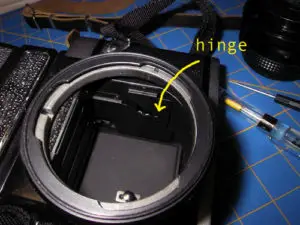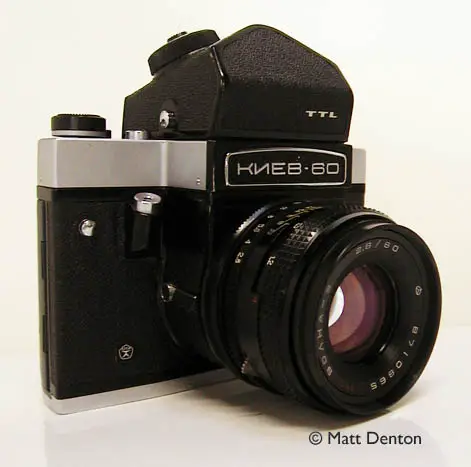- Produced 1984 – present (1987) Arsenal, Kiev, Ukraine
- Film type 120
- Picture size 6cm x 6cm
- Weight 55oz body and prism only, 69oz. with 80mm lens (Holy Boat Anchors, Batman!)
- Lens Volna-3 80mm 1:2.8-22 (Pentacon Six ‘B’ mount)
- Focal range .6m to infinity
- Filter size 62mm
- Shutter cloth curtain
- Shutter speeds B, 1/2-1/1000 (sync at 1/30)
- Viewfinder SLR: prism or optional waist level finder
- Exposure meter TTL CdS in prism
- EV Range 1.6 – 13 (?)
- ASA range 9 – 1000 (DIN 10-31)
- Battery three 675 (for meter only, in prism)
- Accessory shoe, PC sync connection
Overview
It’s big, it’s clunky, it’s super-chunky! It’s… the Kiev 60!
An SLR on steroids, the Kiev 60 is the evolution of a russian copy of the german Pentacon Practisix medium format SLR, which itself was refined into the popular Pentacon Six. Arsenal’s copy, the Kiev 6C, came out in 1971, and then in 1980 the TTL prism version was released. In 1984 the camera was redesigned and released as the Kiev 60 and it is still in production at the time of this writing (2003). Major changes in the 60: the shutter release was moved from the left to the right, and the ability to use 220 film was dropped. All take lenses in Pentacon Six ‘B’ mount. Arsenal is of course the cannon factory -cum- camera factory that churned out great Contax clones by the million during the 20th century. (How old do you feel when you hear that?)
Has the standard MC Volna-3 80mm lens, which is virtually identical to, if not the same as, the MC Arsat-C usually found on the Kiev 88 Hasselblad clone (Arsenal has renamed all of their own lenses ‘Arsat’). The consensus seems to be that a good Volna/Arsat is a great lens but still somewhat inferior to the Zeiss-made Pentacon Six mount lenses. You’ll pay dearly for those bad boys, at least as much as you’ll have paid for your Kiev in the first place. 80mm is of course a normal lens for 6×6, equivalent to a 55mm lens in 35mm format cameras. The focal length is increased to be able to cover the larger negative at the film plane — e.g. all 6×6 TLRs have a 75mm or 80mm taking lens. Thus 150mm-180mm would be the typical portrait lens length for this camera.

(Hm…somehow reminds me of those big furry hats…)
Nice features: removable penatprism, and optional waist level finder (comes in the kit if you’re lucky enough to find a complete box set). And of course, the fact that it’s a MF SLR! Now, because the pentaprism is removable, er, no, that doesn’t make any sense… uh, actually I don’t know why but the meter is in the pentaprism. So if you’re using the waist-level finder you have no meter. Batteries go in the prism, you set the shutter speed there on a separate dial to determine exposure, and then transfer that speed to the camera. Almost as useful as a hand meter! Heh.
Drawbacks include the weight (the whole kit in its case weighs more than my laptop) and the somewhat loud mirror slap. Also, Kiev 60s have a reputation for certain, er eccentricities, though I don’t know that they’re any more prevalent than on any other FSU (former Soviet Union) camera, which seem frequently to need tweaking of some kind or another. Popular fixes for some common problems can be found by following some of the Links below.
Important note – it’s an SLR but the mirror is NOT instant-return, meaning it flips up and stays up till you cock the shutter. This reduces vibration from mirror slap, it’s a big mirror, man. Too bad the Zenit doesn’t have that feature. Ka-chunk! In use the shutter is surprisingly smooth, I think perhaps the size and weight also help dampen the shutter vibration.
Did I mention it was big? Here it is with a Fed-2 for scale:

Repairs
Focusing ring was a little wobbly, and the focusing wasn’t smooth. I took off the focusing ring and the lens surround, cleaned up the threads (there were some little metal bits, probably from the tightening of the set screws into the threads, and general wear). Put it back together straight and tight, and cleaned the glass. MUCH better. I also glued a tiny square of black felt on the inside next to the aperture preview lever to prevent light leakage. So now that makes at least twelve FSU lenses so far that I’ve had apart for one reason or another….
The first half of the first roll I ran through it had a dark bar on one side of each frame. It virtually disappeared by the end of the roll and by the middle of the second roll had disappeared altogether. The expert consensus is that this old dog needed to get out and get some exercise, which I’m having fun facilitating. Reappeared later so I slowed the second shutter curtain by a notch, following Russ’ instructions at the Kievaholic page.
The last thing is that the flash sync was erratic. I peeked inside to see how flash sync was accomplished: part of the internal lever movement that results from the shutter release button stroke touches a bar internally that completes the circuit. Now, sticky levers or failure to press the shutter release quickly and completely can fail to complete this circuit, apparently. I used a Qtip to squish a little synthetic grease on the pivot (accessible inside the mirror box when the mirror is flipped up, on the side with the PC port) and worked the lever it till it was pivoting smoothly. Better, but still misses sometimes.

Followup: Well, after letting it sit a while it was still banding, so I decided to do something I’ve never done before, I decdided to send it off for repair. Back to Kiev, Ukraine no less, to be fixed by the talented folks at Arax-photo who replaced some shutter parts and gave the thing a CLA for less than the cost of round-trip shipping to Ukraine (which isn’t cheap, by the way). SO I feel like I paid for it twice but at least I know that it will do what I want it to, which is be a workhorse in the studio. I’ll probably get another body at some point as a backup. MORAL: a bargain isn’t always a bargain. MORAL 2: a professional CLA is sometimes the way to go when you plan to use a 20 year old camera a lot.
Tips & Tricks
Speaking of Arax, that’s where I got my Kiev-88 adapter, which includes a replacement for the lens retaining ring on the camera body as well as the adapter that allows use of the common Kiev-88 mount lenses. I highly recommend it.
Other stuff — 120 film doesn’t have sprocket holes to help advance and track the film, so only friction can be employed in the film path. Therefore you want to remember to advance the film more slowly than you normally would with a 35mm SLR, but to still advance it in one smooth stroke. Anectodal evidence indicates that in general there seems to be a ‘break-in’ period with new Kiev cameras, where frame spacing and shutter speeds need to work themselves out a bit (usually the first few rolls of film seem to be a little irregular in this respect). From what I’ve seen this is true if it’s sat unused for a while as well, so get out and exercise your Kiev!
Special note: while the actual frame size on the film is 56mm x 56mm, the waistlevel finder shows 53mm x 53mm and the prism finder shows only 49mm x 51.5mm, according to the manual.
BTW the tripod mount is 3/8 not 1/4 so you’ll need an adapter. The small bushing kind is best for this huge camera so the bottom of the camera can fully rest on the pressure plate. Also, no hot shoe, and the cold shoe is a small removable arm that screws onto the front as seen in the picture above. Don’t lose it!
There’s a popular saying about playing Russian Roulette when you’re buying an FSU-made camera, the quality varies wildly depending on how much Vodka the workers had imbibed that day at the factory (or how honest the Ukranian seller is). Which is why some people opt to get a rebuilt model from Hartblei, KievCamera, or KievUSA. Or the reputable folks at Arax-photo for that matter.
Related Links
- Kievgurl has a great site about the Kiev 60
- A page with tips on using the meter, setting frame spacing etc
- The yahoo group on the Kiev 60
- Another great Kiev 60 site complete with embedded ebay search for you impulse buyers
- Even better, how to calibrate and correct your Kiev 60, courtesy of Kievaholic.com
- Further info on the guts of the shutter mechanism
- The Kiev 60 Page at Medium Format Home
- You can also find it here on Nathan Dayton’s comprehensive commiecameras.com
- The manual at Butkus.org
